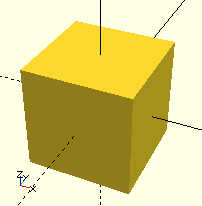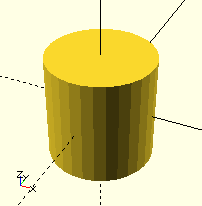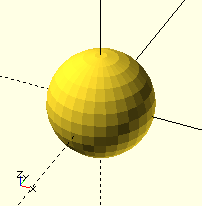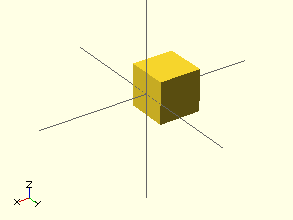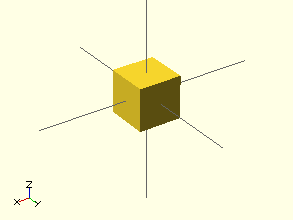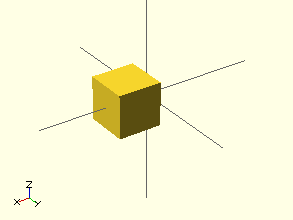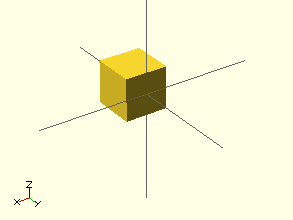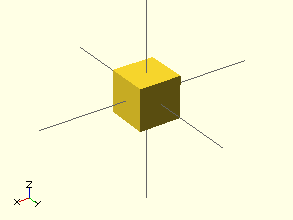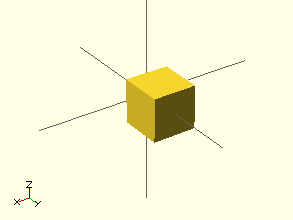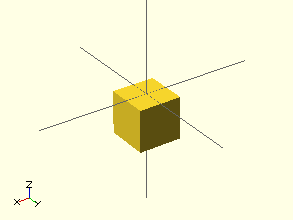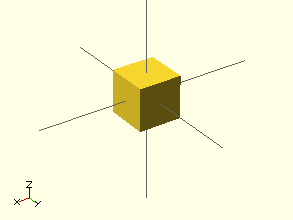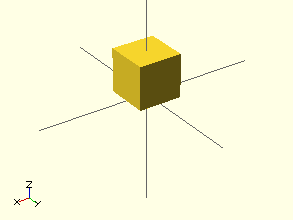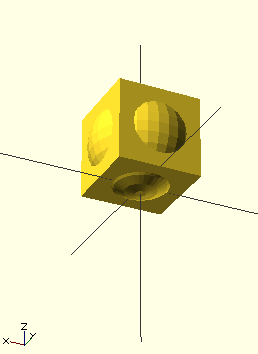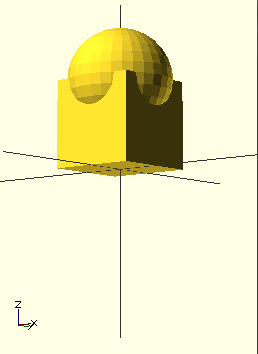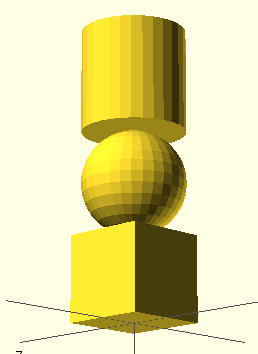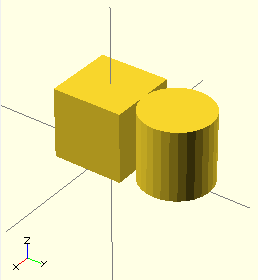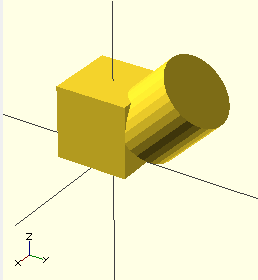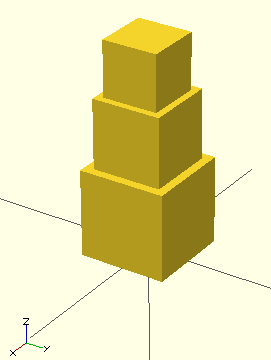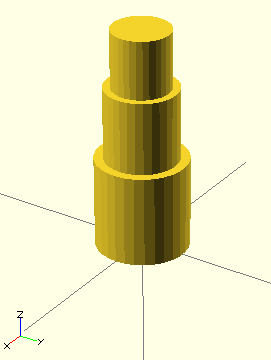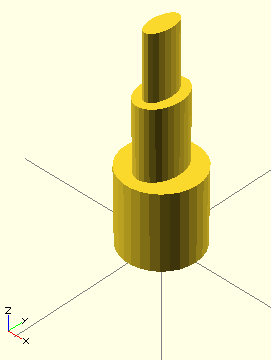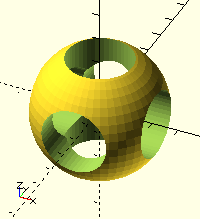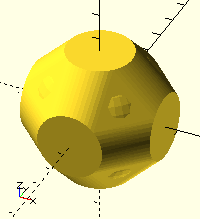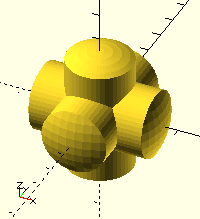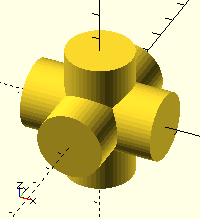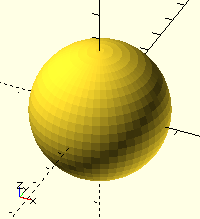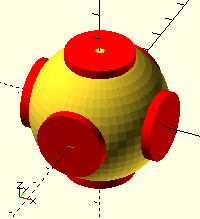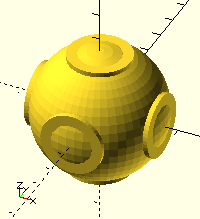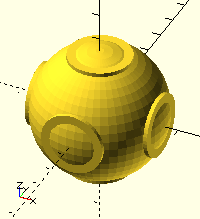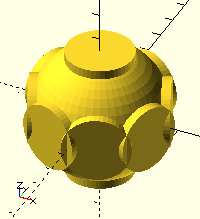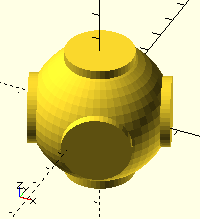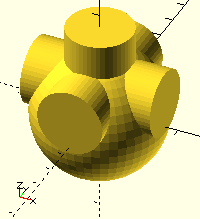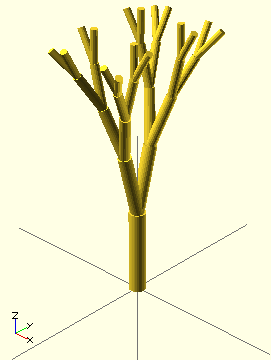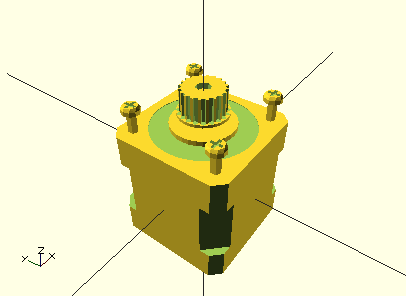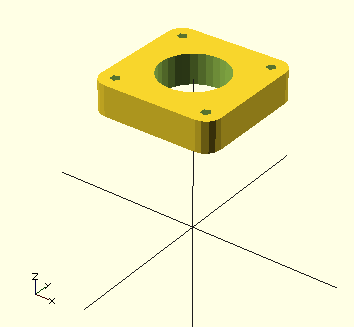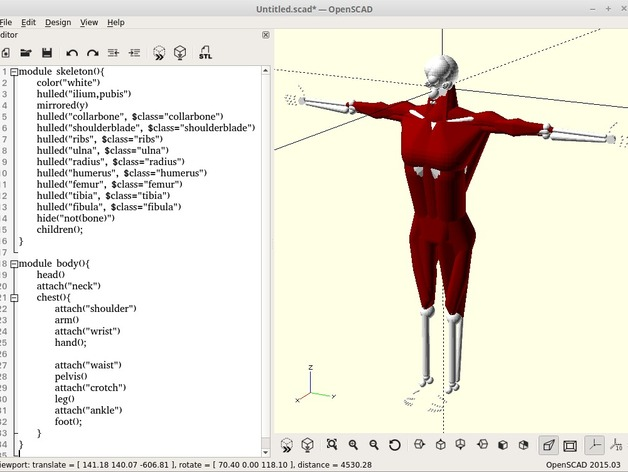Relativity SCAD
Relativity SCAD不是独立语言,只是OpenSCAD的library,但是它提供了一套全新的API替换掉OpenSCAD原有的API的大部分功能,使用起来比OpenSCAD API简单很多。
特别之处:
- 通过描述对象之间的相对位置,大大简化了OpenSCAD建模中繁琐的transformation
- 通过selector对部分对象进行操作,减少了boolean operation的繁琐组合
安装
下载文件后,将其放在计算机上的 OpenSCAD 文件夹中。此文件夹的位置因操作系统而异。启动 OpenSCAD 并键入以下内容:
include <relativity.scad>
使用“include”关键字导入依赖很重要。relativity.scad 需要在其初始化期间声明变量。如果您使用“use”关键字导入 relativity.scad,OpenSCAD 将不会加载这些变量,并且会导致奇怪的行为!
原始实体
这个 OpenSCAD 库增加了相对于其他几何基元的大小、位置和方向对象的功能。
为此,该库引入了一组新模块来替换 OpenSCAD 中的默认几何图元:
如果您需要,所有原始几何图元仍然存在,您可以决定使用多少或多少使用它们。新的原语几乎具有旧版本的所有行为,但有两个重要区别。
Centering
First, in place of center is a new attribute, anchor. This attribute specifies where the axis of rotation is to be placed relative to the object. The anchor attribute is given as a vector whose elements range from -1 (e.g. bottom of axis) to 1 (e.g. top of axis). A value of 0 indicates the anchor is to be centered along an axis.
首先,代替中心的是一个新属性,锚点。此属性指定旋转轴相对于对象的放置位置。锚属性作为一个向量给出,其元素范围从 -1(例如轴的底部)到 1(例如轴的顶部)。值 0 表示锚点将沿轴居中。
Alignment
The second distinction among these new primitives allows for the creation of child objects. By default, a child object is positioned with its origin at the center of its parent:
这些新原语之间的第二个区别允许创建子对象。默认情况下,子对象的原点位于其父对象的中心:
box(50, anchor=[0,0,-1])
sphere(d=55);
this however can be changed using of a second operation, align:
然而,这可以使用第二个操作来改变,对齐:
box(50, anchor=[0,0,-1])
align([0,0,1])
sphere(d=60);
You can align objects along any axis. The value passed to align() is a vector whose elements range from -1 (e.g. bottom of axis) to 1 (e.g. top of axis). A value of 0 indicates an object is to be placed at the center of its parent along that axis.
您可以沿任何轴对齐对象。传递给 align() 的值是一个向量,其元素范围从 -1(例如轴的底部)到 1(例如轴的顶部)。值 0 表示对象将沿该轴放置在其父对象的中心。
| +1 | 0 | -1 | |
|---|---|---|---|
| X | 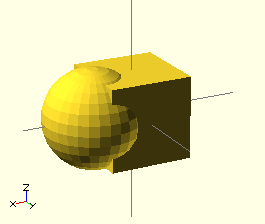 对齐([1,0,0]) | 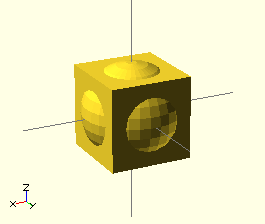 对齐([0,0,0] |  对齐([-1,0,0] |
| Y | 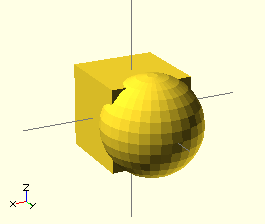 对齐([0,1,0] | 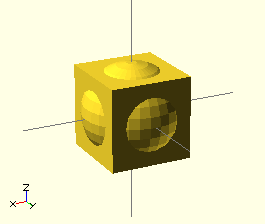 对齐([0,0,0] | 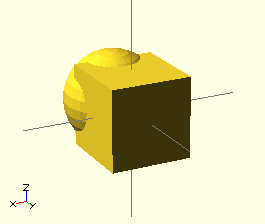 对齐([0,-1,0] |
| Z | 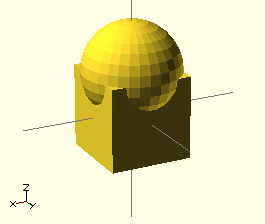 对齐([0,0,1] | 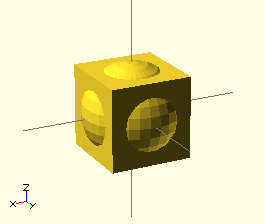 对齐([0,0,0] | 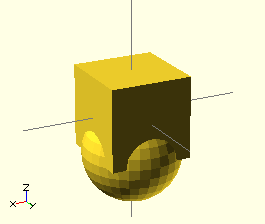 对齐([0,0,-1] |
You can also pass a list of vectors. When you pass a list of vectors, align() will create duplicates of its children in the locations indicated by your vectors.
您还可以传递向量列表。当您传递向量列表时, align() 将在向量指示的位置创建其子项的副本。
box(50, anchor=[0,0,-1])
align([[0,0,1], [0,1,0]])
sphere(d=60);
The examples above use sphere() as their child object. However, ball() can also be be used as a child. Using ball() will allow us to combine align() and anchor, making it easy to stack objects end-to-end:
上面的示例使用 sphere() 作为它们的子对象。但是,ball() 也可以用作子级。使用 ball() 将允许我们结合 align() 和锚点,使端到端堆叠对象变得容易:
box(50, anchor=[0,0,-1]) align([0,0,1]) ball(50, anchor=[0,0,-1]) align([0,0,1]) rod(50, anchor=[0,0,-1]);
To allow for readable code, relativity.scad comes with a few constants representing commonly used values for the align operator:
为了允许代码可读,relativity.scad 带有一些常量,表示对齐运算符的常用值:
top = [0,0,1]; center=[0,0,0]; bottom = [0,0,-1]; x = [1,0,0]; y = [0,1,0]; z = [0,0,1];
It is also possible to combine this constant with + or - operators, since OpenSCAD does (simple) vector calculations.
也可以将此常数与 + 或 - 运算符结合使用,因为 OpenSCAD 进行(简单)矢量计算。
There are also two special variables that are exposed by the align() module, $inward and $outward. $inward points towards the center of a parent object, while $outward points away from it.
align()对齐模块还公开了两个特殊变量,$inward 和 $outward。 $inward 指向父对象的中心,而 $outward 指向远离它的对象。
The anchor parameter defaults to $inward. This is meant to facilitate stacking objects. All told, the code above can be rewritten:
锚参数默认为 $inward。这是为了便于堆叠对象。总而言之,上面的代码可以重写:
box(50) align(top) ball(50) align(top) rod(50);
Orientation
Child objects by default will maintain the same z-axis orientation as their parent objects
默认情况下,子对象将保持与其父对象相同的 z 轴方向
box(50, anchor=[0,0,-1]) align([0,1,0]) rod(d=50, h=50, anchor=[0,-1,0]);
This, however, can be changed with the use of another module, orient. The orient module will redirect the top of a child object to face a given direction. Sometimes rotation using orient can be more intuitive than using rotate
然而,这可以通过使用另一个模块 orient 来改变。 orient 模块将重定向子对象的顶部以面向给定方向。有时使用 orient 进行旋转比使用 rotate 更直观
box(50, anchor=[0,0,-1]) align([0,1,0]) orient([0,1,1]) rod(d=50, h=50, anchor=[0,0,-1]);
You can also pass a list of vectors to orient. In this case, orient will create duplicates of its children with their tops facing the directions you specify in the list.
您还可以将向量列表传递给 orient。在这种情况下, orient 将创建其子项的副本,其顶部朝向您在列表中指定的方向。
//OpenSCAD logo:
differed("hole", "not(hole)")
ball(50)
orient([x,y,z])
rod(d=25, h=50, $class="hole");
Sizing
relativity.scad exposes a dynamic variable, $parent_size, in case there are any unforeseen circumstances where something needs to be done relative to a parent object. This can also be used when setting the size of a child, say, when creating a fractal:
relativity.scad 公开了一个动态变量 $parent_size,以防有任何不可预见的情况需要相对于父对象执行某些操作。这也可以在设置孩子的大小时使用,例如,在创建分形时:
box([50,50,50]) align(top) box(0.8*$parent_size) align(top) box(0.8*$parent_size);
The tree demo provides a good example for the parent() and $parent_size functionality.
树演示为 parent() 和 $parent_size 功能提供了一个很好的示例。
To ease the use of $parent_size, geometric primitives for rod and ball accept size as their first parameter argument, much like cube and box.
为了简化 $parent_size 的使用,棒和球的几何基元接受大小作为它们的第一个参数参数,就像立方体和盒子一样。
rod([50,50,50]) align(top) rod(0.8*$parent_size) align(top) rod(0.8*$parent_size);
An interesting consequence to this means you can pass rod and ball different values for x,y, and z:
一个有趣的结果意味着您可以为 x、y 和 z 传递不同的值:
rod([50,50,50]) align(top) rod([$parent_size.x*.5, $parent_size.y*.7, $parent_size.z*.9]) align(top) rod([$parent_size.x*.5, $parent_size.y*.7, $parent_size.z*.9]);
Another, more unfortunate side effect means rod does not currently support multiple diameters/radii through the d1 and d2 parameters. This may change as need arises. You can still use the original cylinder primitive when circumstances call for it, but a better idea might be to perform the hull between two rods, one of infinitesimal height.
另一个更不幸的副作用意味着杆目前不支持通过 d1 和 d2 参数的多个直径/半径。这可能会随着需要而改变。当情况需要时,您仍然可以使用原始圆柱体原语,但更好的想法可能是在两根杆之间执行船体,其中一根杆的高度非常小。
hulled() rod(d=30, h=infinitesimal) rod(d=10, h=20);
Styling (AKA "CSG")
Relativity.scad transforms the way you work with objects in OpenSCAD. You'll find yourself working a lot more with “tree-like” structures, where geometric primitives nest inside one another. This is similar to the way you write using nested tags in html. Just like html, there is a system for performing operations on the tree-like structure. In html, there's css. In relativity, there's the CSG operations
Relativity.scad 改变了您在 OpenSCAD 中处理对象的方式。您会发现自己更多地使用“树状”结构,其中几何基元相互嵌套。这类似于您在 html 中使用嵌套标签编写的方式。就像 html 一样,有一个系统可以对树状结构进行操作。在html中,有css。在相对论中,有 CSG 操作:
Selectors
Selectors are the means through which CSG operations specify class. Selectors are strings whose format is meant to resemble a subset of CSS selector syntax.
选择器是 CSG 操作指定类的方法。选择器是字符串,其格式类似于 CSS 选择器语法的子集。
Illustrations below uses the following code:
下面的插图使用以下代码:
colored("blue", ...)
ball(50, $class="parent")
{
align(x)
ball(40, $class="child A")
align(x)
ball(30, $class="grandchild");
align(z)
ball(40, $class="child B")
align(z)
ball(30, $class="grandchild");
align(-x)
ball(40, $class="child C")
align(-x)
ball(30, $class="grandchild");
}
As of version 2015.02.14, selectors support the following syntax:
从 2015.02.14 版本开始,选择器支持以下语法:

